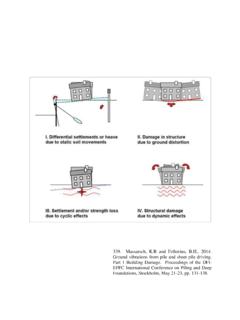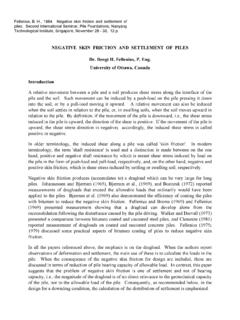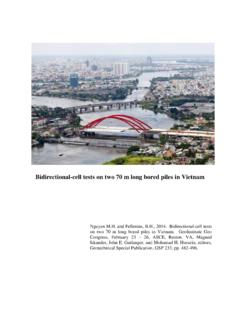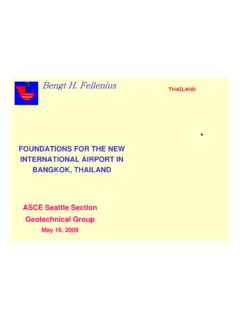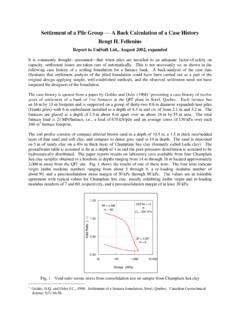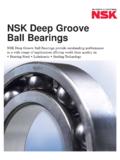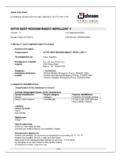Transcription of Deep vibratory compaction of granular soils - …
1 deep vibratory compaction of granular soils K. Rainer Massarsch Geo Engineering AB Feriev gen 25, S-161 51 Bromma, Sweden > and Bengt H. Fellenius Bengt Fellenius Consultants Inc. 1905 Alexander Street, Calgary, Alberta, T2G 4J3 Massarsch, and Fellenius, , 2005. deep vibratory compaction of granular soils . Chapter 19 in Ground Improvement-Case Histories, Elsevier publishers, B. Indranatna and C. Jian, Editors, pp. 633 - 658. deep vibratory compaction of granular soils K. Rainer Massarsch Geo Engineering AB, Feriev gen 25, SE 168 41 Bromma, Sweden Bengt H. Fellenius Bengt Fellenius Consultants Inc., 1905 Alexander Street SE, Calgary, Alberta, Canada ABSTRACT Planning and execution of deep vibratory compaction of natural and man-made fills requires recognition of fundamental soil aspects, such as the compactability of soils .
2 Design is usually based on cone penetration tests and carried out with equipment specially developed for deep vibratory compaction , in particular, using variable frequency vibrators. The features of different, purpose-built types of compaction probes are described and the most important factors governing the compaction process are presented, such as vibration frequency an important parameter as it influences probe penetration and can enhance compaction by means of resonance effects during the compaction phase. vibratory compaction generates lateral stresses, which result in a permanent increase of the horizontal earth pressure and overconsolidation. The practical importance of these effects is discussed. 1.
3 INTRODUCTION Where granular soils have inadequate compressibility or strength, resorting to soil compaction is usually viable and economical, and applicable to both shallow and deep foundations. compaction is particularly useful where the foundations will be subjected to dynamic and cyclic loading. By compaction is meant densification by dynamic methods, which, depending on the manner of imparting the energy to the soil , can be divided into two main categories: impact compaction and vibratory compaction . The methods and their practical applications are described extensively in the geotechnical literature, , Massarsch (1991; 1999), Mitchell (1981) and Schlosser (1999). vibratory compaction methods have found wide acceptance, and numerous case histories have been described in the geotechnical literature, illustrating their practical applications.
4 However, only limited information is available on the fundamental aspects of vibratory compaction that govern the planning, execution, and evaluation of vibratory compaction projects. This paper discusses, based on the evaluation of numerous case histories, different aspects of deep vibratory compaction with emphasis placed on field execution and monitoring. The effect on soil strength and stiffness, as well as the resulting change of stress conditions in coarse-grained soils are addressed, as these are of importance for geotechnical design of the foundations to be placed on the compacted soil . In the recent past, vibratory compaction methods have become more competitive due to several important developments, as follows, powerful construction equipment ( vibrators and cranes) has become available, making it possible to achieve higher compaction and to reach deeper into the soil , more reliable geotechnical field investigation tools, such as electric cone penetrometers (CPT), piezocones (CPTU), seismic cones (SCPT), dilatometers (DMT), and pressuremeters (PMT)
5 , improved understanding of the static, dynamic, and cyclic behaviour of soils , which has made it possible to model deformation characteristics of soils more accurately, more sophisticated analytical and numerical methods for predicting settlements, soil -structure interaction, or the dynamic response of soil deposits during an earthquake, increase in the reliability of electronic equipment for use in rough site conditions, important for monitoring and documenting the compaction process. The planning of vibratory compaction requires geotechnical competence and careful planning on the part of the design engineer. Similarly, the contractor needs to possess experience and suitable equipment to carry out deep soil compaction . It is common practice to award soil compaction projects to the lowest bidder.
6 However, after completion of a project, this may not always turn out to be the optimal solution, if the required compaction is not achieved, or the duration of work is significantly exceeded. The selection of the most suitable compaction process depends on a variety of factors: soil conditions, required degree of compaction , type of structure to be supported, maximum depths of compaction , site-specific considerations such as sensitivity of adjacent structures or installations, available time for completion of the project, access to equipment and material, and, not least, the competence of contractor. Moreover, it is paramount for all types of soil compaction projects that a high degree of quality control and site supervision is maintained. 2. COMPACTABILITY OF soils One of the most important questions to be answered by the geotechnical engineer is whether or not and to which degree a soil deposit can be improved by dynamic methods ( vibratory or impact compaction ).
7 Mitchell (1982) identified suitable soil types according to grain size distribution and indicated that most coarse-grained soils with a "fines content" (amount of particles smaller than mm, Sieve #200) below 10 % can be compacted by vibratory and impact methods. However, compaction assessment based on grain-size curves from sieve analysis has the disadvantage that, in order to obtain a realistic picture of the geotechnical conditions, a large number of soil samples and sieve analyses is required larger than what is usually considered justifiable for a routine foundation project Going back to a site in order to obtain additional samples is impractical due to time constraints. Moreover, obtaining representative soil samples may prove to be difficult and costly because the soils at such sites are usually loose and water-saturated.
8 Moreover, soil lenses and layers of importance for the assessment may not be evident from the inspection of soil samples obtained intermittently. It is therefore preferable to base the assessment of compactability on results of the CPT, as these measurements present continuous soil profiles reflecting variations in soil strength and compressibility, and, in the case of the piezocone, also variations in hydraulic conductivity of the soil . Massarsch (1991) proposed that the compactability of soils can be classified as compactable , marginally compactable , and not compactable . Figure 1 presents a conventional soil classification chart with the friction ratio along the abscissa and the cone resistance (qt) along the ordinate. (It should be noted that the diagram assumes homogeneous soil conditions.)
9 Layers of silt and clay can inhibit the dissipation of excess pore pressures and, therefore, reduce the compaction effectiveness). Fig. 1. soil classification for deep compaction based on CPT data. After Massarsch, (1991). Figure 2 shows the same compaction boundaries where the cone stress (cone resistance) is shown as a function of the sleeve friction (Eslami and Fellenius, 1995; 1997; and Fellenius and Eslami, 2000). As the ranges of cone stress and sleeve friction applicable to compaction projects are relatively narrow, the usual logarithmic-scale compression of the axes can be dispensed with and Fig. 2 be shown in linear scale axes. compaction criteria are frequently expressed in terms of cone stress unadjusted for overburden stress (depth). However, similar to the depth adjustment employed for SPT data, it is preferable to express CPT compaction criteria in terms of a cone stress value adjusted with respect to the mean effective stress.
10 Expressing compaction specifications in terms of the stress-adjusted cone stress will better reflect uniformity of soil density, or lack of uniformity, as opposed to using the unadjusted cone stress. If the cone data are not adjusted according to the stress level (depth), applying a specific value of cone stress as a compaction criterion throughout a soil deposit may lead to the upper layers of the deposit becoming overcompacted while the deeper layers remain loose. When this aspect is not recognized, the result is excessive compaction costs, undesirable loss of ground, and a soil deposit that is not uniformly compacted. 0123456789100255075100 Sleeve Friction (KPa)Cone Stress, qE (MPa) Compactable1234b5 Marginally Compactable Not Compactable4a Fig. 2. soil classification for deep compaction based on the Eslami-Fellenius chart with boundaries from Fig.

